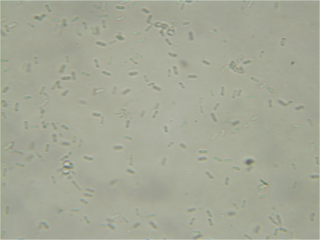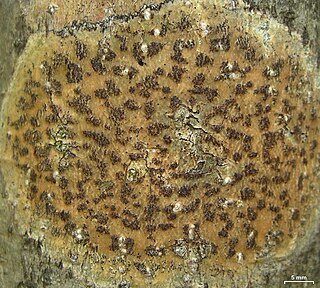Ascochyta medicaginicola is a plant pathogen infecting alfalfa and Medicago truncatula. One particular disease is spring black stem.
Didymella arachidicola is a plant pathogen.
Stagonosporopsis trachelii is a fungal plant pathogen that causes Ascochyta leaf spot in Campanula species.

Ascochyta pisi is a fungal plant pathogen that causes ascochyta blight on pea, causing lesions of stems, leaves, and pods. These same symptoms can also be caused by Ascochyta pinodes, and the two fungi are not easily distinguishable.
Boeremia lycopersici is a fungal plant pathogen infecting tomatoes and strawberries.
Phoma cucurbitacearum is a fungal plant pathogen infecting cucurbits.
Coniothyrium glycines is a fungal plant pathogen infecting soybean.
Phoma herbarum is a fungal plant pathogen infecting various plant species, including Alchemilla vulgaris, Arabis petraea, Arenaria norvegica, Armeria maritima, Bartsia alpina, Capsella bursa-pastoris, Erysimum, Euphrasia frigida, Honckenya peploides, Matricaria maritima, Rumex longifolius, Thymus praecox and Urtica dioica.
Phoma microspora is a fungal plant pathogen known for infecting peanuts.
Phoma nebulosa is a fungal plant pathogen infecting spinach.
Phoma strasseri is a fungal plant pathogen infecting mint.
Phoma tracheiphila is a fungal plant pathogen. It causes a disease known as Mal secco on citrus trees. It occurs in dry, cool climates such as the Mediterranean, Black Sea and Asia Minor. It forms pycniospores that are carried short distances by rain, or by wind to new leaves, where germinated hyphae invade stomata or more likely fresh wounds.

Phoma destructiva is a fungal plant pathogen infecting tomatoes and potatoes.
Phoma exigua var. foveata is a fungal plant pathogen infecting potatoes.

The Pleosporales is the largest order in the fungal class Dothideomycetes. By a 2008 estimate, it contained 23 families, 332 genera and more than 4700 species. The majority of species are saprobes on decaying plant material in fresh water, marine, or terrestrial environments, but several species are also associated with living plants as parasites, epiphytes or endophytes. The best studied species cause plant diseases on important agricultural crops e.g. Cochliobolus heterostrophus, causing southern corn leaf blight on maize, Phaeosphaeria nodorum causing glume blotch on wheat and Leptosphaeria maculans causing a stem canker on cabbage crops (Brassica). Some species of Pleosporales occur on animal dung, and a small number occur as lichens and rock-inhabiting fungi.

Phoma is a genus of common coelomycetous soil fungi. It contains many plant pathogenic species.

The Trypetheliales are an order of fungi in the class Dothideomycetes. Most of the species in the order form lichens, although some are lichenicolous fungi. Trypetheliales contains two families, Polycoccaceae and Trypetheliaceae. The order was circumscribed in 2008 by lichenologists Robert Lücking, André Aptroot, and Harrie Sipman.
Phoma narcissi is a fungal plant pathogen of Narcissus, Hippeastrum and other Amaryllidaceae, where it causes a leaf scorch, neck rot and red leaf spot disease
Phoma wilt is a disease of the common hop plant caused by several species of fungal plant pathogens in the genus Phoma. These include Phoma herbarum and Phoma exigua, and possibly other as yet unidentified species. Phoma infection may cause decreased yields, but Phoma wilt is not considered to be a very common or destructive disease of the hop plant.
Briancoppinsia is a fungal genus in the family Arthoniaceae. It is monotypic, containing the single species Briancoppinsia cytospora, a lichenicolous fungus that parasitises parmelioid lichens, as well as Cladonia, Lepra, and Lecanora conizaeoides, among others. The species was first described scientifically by Léon Vouaux in 1914 as Phyllosticta cytospora. The genus was circumscribed in 2012 by Paul Diederich, Damien Ertz, James Lawrey, and Pieter van den Boom. The genus was named for Brian John Coppins, who is, according to the authors, an "eminent British lichenologist and expert of lichenicolous fungi".




